HOUSTON CHRONICLE BUILDING GOES ON SALE TOMORROW, THE CHRONICLE REPORTS 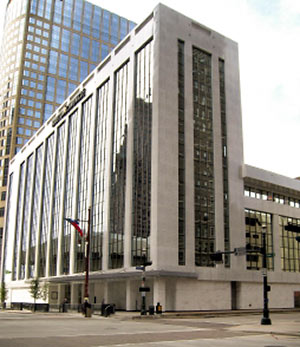 The Houston Chronicle’s 10-story downtown headquarters and neighboring parking garage will be listed for sale tomorrow — with the Hearst newspaper’s reporters and other employees still working away inside. “Chronicle executives said prospective buyers have already expressed interest in the property and that more are expected once word spreads that the building at 801 Texas and an adjacent parking garage are up for sale,” writes real estate reporter Nancy Sarnoff from somewhere inside the complex. Indeed, company executives have already suggested to her the story’s conclusion: “’This building is likely to be torn down and replaced with a modern skyscraper that will generate more revenue for the city. It’s in a prime location,’ Paul Barbetta, executive vice president and chief operating officer of the Houston Chronicle Media Group, said Monday.” Chronicle employees will be allowed to exit the building and take their belongings with them to a revamped, smaller,
The Houston Chronicle’s 10-story downtown headquarters and neighboring parking garage will be listed for sale tomorrow — with the Hearst newspaper’s reporters and other employees still working away inside. “Chronicle executives said prospective buyers have already expressed interest in the property and that more are expected once word spreads that the building at 801 Texas and an adjacent parking garage are up for sale,” writes real estate reporter Nancy Sarnoff from somewhere inside the complex. Indeed, company executives have already suggested to her the story’s conclusion: “’This building is likely to be torn down and replaced with a modern skyscraper that will generate more revenue for the city. It’s in a prime location,’ Paul Barbetta, executive vice president and chief operating officer of the Houston Chronicle Media Group, said Monday.” Chronicle employees will be allowed to exit the building and take their belongings with them to a revamped, smaller, outside-the-Loop just-inside-the-Loop facility before that happens. [Prime Property; previously on Swamplot] Photo: Walter P Moore
Quicklink
COMMENT OF THE DAY: HOW IT WORKS IN HOUSTON, THE FREE ENTERPRISE CITY  “. . . That is, and always has been, Houston. That unruly sprawl, those cookie-cutter suburbs, generic strip malls, traffic congestion, that all existed long before the Beltway was built. I grew up here, in a cookie-cutter suburb called ‘Sagemont’ located next to a 2 lane stretch of blacktop named ‘South Belt.’ My dad grew up in a cookie-cutter suburb 10 miles closer in, filled with generic strip malls, just outside what would become the 610 Loop. Today I live in another cookie-cutter suburb farther west, about half way between 610 and the Beltway. Still lots of congestion, sprawl, strip centers, etc. This is Houston, baby.
And just about everything in Houston exists because some powerful person (not necessarily a politician) owned tracts of land. All of those hip dense neighborhoods? They were empty fields that some speculator bought for next to nothing, then bribed . . . er, influenced someone in government to build something, often with tax dollars. That’s how things get done.” [Memebag, commenting on Driving Beltway 8, in Order To Read Houston in the Original] Illustration: Lulu
“. . . That is, and always has been, Houston. That unruly sprawl, those cookie-cutter suburbs, generic strip malls, traffic congestion, that all existed long before the Beltway was built. I grew up here, in a cookie-cutter suburb called ‘Sagemont’ located next to a 2 lane stretch of blacktop named ‘South Belt.’ My dad grew up in a cookie-cutter suburb 10 miles closer in, filled with generic strip malls, just outside what would become the 610 Loop. Today I live in another cookie-cutter suburb farther west, about half way between 610 and the Beltway. Still lots of congestion, sprawl, strip centers, etc. This is Houston, baby.
And just about everything in Houston exists because some powerful person (not necessarily a politician) owned tracts of land. All of those hip dense neighborhoods? They were empty fields that some speculator bought for next to nothing, then bribed . . . er, influenced someone in government to build something, often with tax dollars. That’s how things get done.” [Memebag, commenting on Driving Beltway 8, in Order To Read Houston in the Original] Illustration: Lulu
COMMENT OF THE DAY: HOW THOSE NEW FIFTH WARD DRIVEWAYS CAME TO REACH ALL THE WAY INTO THE MIDDLE OF THE STREET 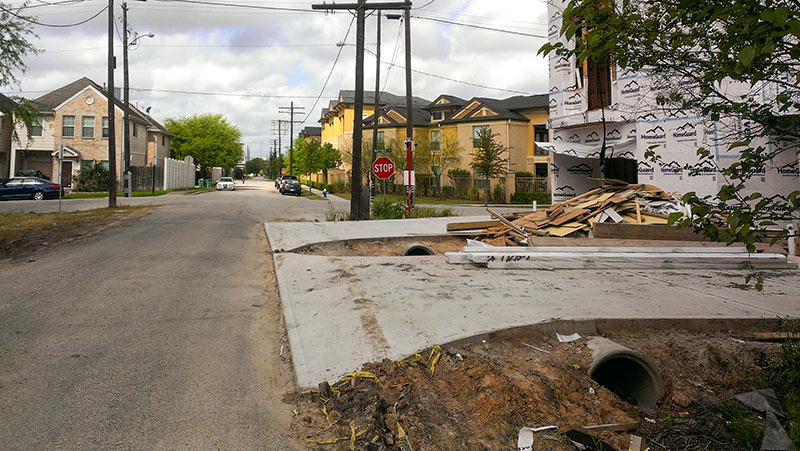 “Here’s how you get to this point.
(i) Neighborhood gets built with gravel streets, ditch drainage.
(ii) City goes in and widens most of the streets in the neighborhood in the 1960s. 40′ asphalt, curb and gutter. Baron St. misses out on the neighborhood-wide repave because it has a railroad track in the middle.
(iii) Railroad track gets abandoned, trackbed gets paved over, no one ever improves Baron.
(iv) Townhome developer comes in and wants to put in a driveway. Houston Infrastructure Design Manual says any culvert in City right-of-way has to be 24″ minimum. Developer’s engineer knows if he touches that old 60s curb inlet he’ll have to replace it to current spec, better to match the flowline and save eight or ten large. Culverts go in and look huge because 24″ on top of the existing flowline is above the crown of the road.
(v) Swamplot readers are confused because the 60s-era curb and gutter doesn’t match the existing right-of-way.” [Purple CIty, commenting on Here’s One Way To Get Extra Long Driveways for Your Fifth Ward Townhome] Photo: Swamplot inbox
“Here’s how you get to this point.
(i) Neighborhood gets built with gravel streets, ditch drainage.
(ii) City goes in and widens most of the streets in the neighborhood in the 1960s. 40′ asphalt, curb and gutter. Baron St. misses out on the neighborhood-wide repave because it has a railroad track in the middle.
(iii) Railroad track gets abandoned, trackbed gets paved over, no one ever improves Baron.
(iv) Townhome developer comes in and wants to put in a driveway. Houston Infrastructure Design Manual says any culvert in City right-of-way has to be 24″ minimum. Developer’s engineer knows if he touches that old 60s curb inlet he’ll have to replace it to current spec, better to match the flowline and save eight or ten large. Culverts go in and look huge because 24″ on top of the existing flowline is above the crown of the road.
(v) Swamplot readers are confused because the 60s-era curb and gutter doesn’t match the existing right-of-way.” [Purple CIty, commenting on Here’s One Way To Get Extra Long Driveways for Your Fifth Ward Townhome] Photo: Swamplot inbox
COMMENT OF THE DAY RUNNER-UP: RETAIL CHAIN SLEEP SYNERGY  “I wonder if Mattress Firm/Pro geographically correlate with CVS/Walgreens stores, i.e. the drug sellers who provide customers with the means (Ambien, Lunesta) to enjoy a full and long-lasting experience on their newly purchased mattresses.” [Larry, commenting on How and Where Mattress Firm Is Conquering Houston, One Sleepy Strip Center Storefront at a Time] Illustration: Lulu
“I wonder if Mattress Firm/Pro geographically correlate with CVS/Walgreens stores, i.e. the drug sellers who provide customers with the means (Ambien, Lunesta) to enjoy a full and long-lasting experience on their newly purchased mattresses.” [Larry, commenting on How and Where Mattress Firm Is Conquering Houston, One Sleepy Strip Center Storefront at a Time] Illustration: Lulu
DRIVING BELTWAY 8, IN ORDER TO READ HOUSTON IN THE ORIGINAL  “To get a full sense of the place,” writes Cort McMurray, every Houstonian should travel Beltway 8’s full 83-mile circuit. Until you can find the time, though, his tour narrative may have to suffice: “Keep going. You’re not even halfway around. There are more factories, and more office buildings, more new construction, more traffic. There’s a steak house, built to look like Sam Houston’s Huntsville home, evidence that if you give a Houstonian a little time and a little encouragement and the right financing, a Houstonian will create something ridiculous, and the horse track, where nothing ever appears to be happening. Near Bush Intercontinental, you’ll endure Roadwork Purgatory: orange cones and narrowed lanes and blinking signs, and no evidence of any work being done. It’s been that way for 19 years.
East of the airport, the Beltway crosses vast swaths of tract homes and the strip centers and megachurches that inevitably follow them, funneling you toward the Jesse Jones Bridge, standing like the skeleton of some humongous sauropod, head forever bent to the Ship Channel, nosing about for some seaweed.” [OffCite] Photo of Steamboat House Steakhouse: Tomball Sesquicentennial Promenaders
“To get a full sense of the place,” writes Cort McMurray, every Houstonian should travel Beltway 8’s full 83-mile circuit. Until you can find the time, though, his tour narrative may have to suffice: “Keep going. You’re not even halfway around. There are more factories, and more office buildings, more new construction, more traffic. There’s a steak house, built to look like Sam Houston’s Huntsville home, evidence that if you give a Houstonian a little time and a little encouragement and the right financing, a Houstonian will create something ridiculous, and the horse track, where nothing ever appears to be happening. Near Bush Intercontinental, you’ll endure Roadwork Purgatory: orange cones and narrowed lanes and blinking signs, and no evidence of any work being done. It’s been that way for 19 years.
East of the airport, the Beltway crosses vast swaths of tract homes and the strip centers and megachurches that inevitably follow them, funneling you toward the Jesse Jones Bridge, standing like the skeleton of some humongous sauropod, head forever bent to the Ship Channel, nosing about for some seaweed.” [OffCite] Photo of Steamboat House Steakhouse: Tomball Sesquicentennial Promenaders
COMMENT OF THE DAY: WHAT YOU’VE EARNED  “How do you have the time to use all the various leisure areas of a house like this? You gotta be working a lot to afford it so when do you have the free time to ski, play hoops, work out, dine in the dining room, swim in the pools, sit in one of all the outdoor sitting areas, sit in the kitchen or the bar or the living room or the den and so on . . .” [jost, commenting on Katy Home Listing Photo of the Day: Can’t Miss] Illustration: Lulu
“How do you have the time to use all the various leisure areas of a house like this? You gotta be working a lot to afford it so when do you have the free time to ski, play hoops, work out, dine in the dining room, swim in the pools, sit in one of all the outdoor sitting areas, sit in the kitchen or the bar or the living room or the den and so on . . .” [jost, commenting on Katy Home Listing Photo of the Day: Can’t Miss] Illustration: Lulu
LATE MAY OPENINGS FOR SOUTHEAST AND EAST END RAIL LINES 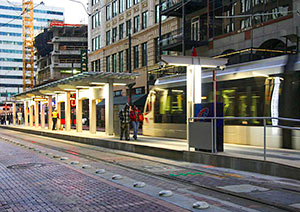 An official opening date has finally been set for Houston’s 2 new light-rail lines — and it’ll be later than the expected early-April debut. The East End and Southeast Lines will both open May 23rd, the Metro board announced this morning. [Houston Metro on Twitter; previously on Swamplot] Photo of new Central Station downtown: Metro
An official opening date has finally been set for Houston’s 2 new light-rail lines — and it’ll be later than the expected early-April debut. The East End and Southeast Lines will both open May 23rd, the Metro board announced this morning. [Houston Metro on Twitter; previously on Swamplot] Photo of new Central Station downtown: Metro
COMMENT OF THE DAY: THE MIDTOWN SUPERBLOCK’S NOT SO SUPER FUTURE  “The site plan for this block, where the apartment complex stands like J.J. Watt blocking the retail from the park for which it should have been the activity generator, stands as a symbol of a city at a pivot point in its urbanization, where all the lessons it has learned the past ten years still can’t make up for the decades it snoozed in urban neglect and public space amnesia. Imagine if you took the George R. Brown and dropped it halfway across Discovery Green, splitting the park’s integral components and killing its interaction with surrounding elements — that is the Superblock in a nutshell. Midtown will still benefit from a central greenspace, and the little pocket park at the north end might turn out to be something nice. But however modestly successful this becomes will only be a painful reminder of what could have been.” [Mike, commenting on Can’t Get Enough Midtown Superblock? New Video Captures Every Puddle, Blade of Grass, Mud Patch] Site diagram: Lulu
“The site plan for this block, where the apartment complex stands like J.J. Watt blocking the retail from the park for which it should have been the activity generator, stands as a symbol of a city at a pivot point in its urbanization, where all the lessons it has learned the past ten years still can’t make up for the decades it snoozed in urban neglect and public space amnesia. Imagine if you took the George R. Brown and dropped it halfway across Discovery Green, splitting the park’s integral components and killing its interaction with surrounding elements — that is the Superblock in a nutshell. Midtown will still benefit from a central greenspace, and the little pocket park at the north end might turn out to be something nice. But however modestly successful this becomes will only be a painful reminder of what could have been.” [Mike, commenting on Can’t Get Enough Midtown Superblock? New Video Captures Every Puddle, Blade of Grass, Mud Patch] Site diagram: Lulu
HOW THE 610 LOOP EARNED ITS PRESTIGE 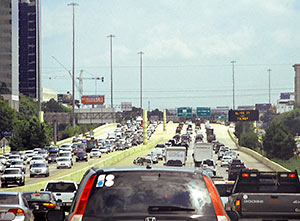 “I’ve heard 610 called a lot of things, but never ‘prestigious,'” writes a Swamplot reader who is curious to learn how the phrase “the prestigious 610 Loop” nevertheless came to appear in Wikipedia — in the entry for Hines’s gated Somerset Green complex, now under construction on 46 acres of an old industrial operation at 7002 Old Katy Rd., just east of the Houston Design Center. Ah, but such is the value of Wikipedia’s references and external links sections: The source of the phrase turns out to be Hines itself. A press release that predates by a couple of years the billboards now seen advertising the 500-home development along a few (less-prestigious, no doubt) Inner Loop highways still bears the implicit declaration in its headline: “Hines to Develop 46-acre Planned Community Inside Houston’s Prestigious 610 Loop.” And so it is. [Wikipedia; press release] Photo of the 610 Loop: PINKÉ (license)
“I’ve heard 610 called a lot of things, but never ‘prestigious,'” writes a Swamplot reader who is curious to learn how the phrase “the prestigious 610 Loop” nevertheless came to appear in Wikipedia — in the entry for Hines’s gated Somerset Green complex, now under construction on 46 acres of an old industrial operation at 7002 Old Katy Rd., just east of the Houston Design Center. Ah, but such is the value of Wikipedia’s references and external links sections: The source of the phrase turns out to be Hines itself. A press release that predates by a couple of years the billboards now seen advertising the 500-home development along a few (less-prestigious, no doubt) Inner Loop highways still bears the implicit declaration in its headline: “Hines to Develop 46-acre Planned Community Inside Houston’s Prestigious 610 Loop.” And so it is. [Wikipedia; press release] Photo of the 610 Loop: PINKÉ (license)
NOW IT’S 2 MATTRESS STORES MOVING IN RIGHT NEXT TO EACH OTHER AT THE CORNER OF WESTHEIMER AND MONTROSE 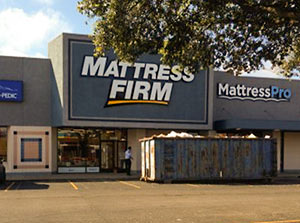 Montrose watchdogs worried about the aura of chain-store sameness about to descend on the center-of-it-all corner of Westheimer Rd. and Montrose Blvd. once the new Mattress Firm store opens in the former Blockbuster Video spot at 1002 Westheimer: The nation’s largest purveyor of all things mattress understands your concerns. That’s why, this time, it’s mixing it up. As reporter Katherine Feser discovers, a separate store for the same company’s lower-priced (and normally outside-the-Loop) chain, Mattress Pro, will be moving in right next door. [Houston Chronicle] Photo: Katherine Feser/Houston Chronicle
Montrose watchdogs worried about the aura of chain-store sameness about to descend on the center-of-it-all corner of Westheimer Rd. and Montrose Blvd. once the new Mattress Firm store opens in the former Blockbuster Video spot at 1002 Westheimer: The nation’s largest purveyor of all things mattress understands your concerns. That’s why, this time, it’s mixing it up. As reporter Katherine Feser discovers, a separate store for the same company’s lower-priced (and normally outside-the-Loop) chain, Mattress Pro, will be moving in right next door. [Houston Chronicle] Photo: Katherine Feser/Houston Chronicle
COMMENT OF THE DAY: HOUSTON’S REALLY GOOD OLD DAYS ARE GONE FOREVER  “The whole Houston region used to be a beautiful coastal plain where my family and extended family lived harmoniously with nature before 5,000,000 people showed up and paved over the whole damn place and called it Houston. Now I’m sad.
— Sincerely,
Karankawa Nation” [Bernard, commenting on Comment of the Day: What the House Meant] Illustration: Lulu
“The whole Houston region used to be a beautiful coastal plain where my family and extended family lived harmoniously with nature before 5,000,000 people showed up and paved over the whole damn place and called it Houston. Now I’m sad.
— Sincerely,
Karankawa Nation” [Bernard, commenting on Comment of the Day: What the House Meant] Illustration: Lulu
COMMENT OF THE DAY: WHAT THE HOUSE MEANT 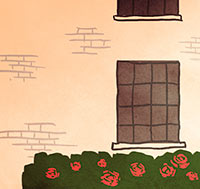 “My great-great grandparents purchased the land mentioned in the above article when there were just a few houses on the street, and the street was not yet paved. They built this house and 3 generations of my family lived together under its roof at one time. My grandparents met working at the movie theater that used to stand in the Village Arcade. My grandfather was an usher and my grandmother was a concession girl. He used to sneak her out of her bedroom window for dates when she was 15 and he was 16, a few years before he joined the Navy to fight in WWII. My great-grandfather planted rose bushes in front of his daughter’s bedroom window to stop her from climbing out. When my grandparents were first married, they lived in the house with her parents and grandparents. My parents lived in the house after they got married, and I lived my whole life on Chaucer until I got married. My grandfather remained in the house long after his wife passed, and himself lived there until he passed away early last year. All of my best memories were set within those walls, all the family meals, holidays and birthdays.
Driving past the muddy, empty lot felt like looking at someone’s usual armchair after they’ve passed away and expecting to see them sitting there, right as rain. Seeing those beautiful bone-colored porcelain bricks trampled under tire tracks . . . It took the air out of me. I hope that by sharing this history, people will understand that sometimes, a house is more than just 4 walls and a roof; this house was more than just a location and a parcel of land. Sometimes, it is the root that anchors us to our past, to our identity, to our origin.” [B Ferguson, commenting on Two Home Demos Mark Rice University’s Continuing March into Rice Village] Illustration: Lulu
“My great-great grandparents purchased the land mentioned in the above article when there were just a few houses on the street, and the street was not yet paved. They built this house and 3 generations of my family lived together under its roof at one time. My grandparents met working at the movie theater that used to stand in the Village Arcade. My grandfather was an usher and my grandmother was a concession girl. He used to sneak her out of her bedroom window for dates when she was 15 and he was 16, a few years before he joined the Navy to fight in WWII. My great-grandfather planted rose bushes in front of his daughter’s bedroom window to stop her from climbing out. When my grandparents were first married, they lived in the house with her parents and grandparents. My parents lived in the house after they got married, and I lived my whole life on Chaucer until I got married. My grandfather remained in the house long after his wife passed, and himself lived there until he passed away early last year. All of my best memories were set within those walls, all the family meals, holidays and birthdays.
Driving past the muddy, empty lot felt like looking at someone’s usual armchair after they’ve passed away and expecting to see them sitting there, right as rain. Seeing those beautiful bone-colored porcelain bricks trampled under tire tracks . . . It took the air out of me. I hope that by sharing this history, people will understand that sometimes, a house is more than just 4 walls and a roof; this house was more than just a location and a parcel of land. Sometimes, it is the root that anchors us to our past, to our identity, to our origin.” [B Ferguson, commenting on Two Home Demos Mark Rice University’s Continuing March into Rice Village] Illustration: Lulu
JUST A BUNCH OF GUYS HANGING OUT ON THE ASTRODOME ROOF  Astrodome security wasn’t the tightest during the Rodeo of 2012, it appears. That’s when builder Russell Hancock snuck inside the unused stadium and sent photos of some of the sorry scenes he found there to Swamplot — sparking a spate of media interest in the long-ignored venue. But Hancock wasn’t the Astrodome’s only unauthorized visitor that year. Brewskies in hand, 4 dudes with cameraphones also snuck into the structure, though it appears they spent much of their time exploring the structure’s peripheral spaces. Over this past weekend, one of the 4 posted an album of pix from their years-ago nighttime venture, the stars of which are the explorers themselves; with blanked-out faces, they’re seen hanging out in locker rooms, hiding in ice machines, operating the scoreboard controls, and pretending to tend bar in an upper-level suite. The highlight, though, is clearly the roofwalk: “After walking around on the top floor,” the anonymous poster writes, “I decided we should try to find our way onto the roof. Not kidding at all — the first door I opened, what looked like a closet door, had a ladder in it. So of course we climbed that shit. It went up about 15 ft. to a hatch that wasn’t locked. So we popped our head out and there was the roof. To the Astrodome. It was surreal. We started to climb up the sky lights to try to get to the top, but about 20—30 ft. up we realized that was probably not the best idea.” [imgur] Photos: Astrodome713
Astrodome security wasn’t the tightest during the Rodeo of 2012, it appears. That’s when builder Russell Hancock snuck inside the unused stadium and sent photos of some of the sorry scenes he found there to Swamplot — sparking a spate of media interest in the long-ignored venue. But Hancock wasn’t the Astrodome’s only unauthorized visitor that year. Brewskies in hand, 4 dudes with cameraphones also snuck into the structure, though it appears they spent much of their time exploring the structure’s peripheral spaces. Over this past weekend, one of the 4 posted an album of pix from their years-ago nighttime venture, the stars of which are the explorers themselves; with blanked-out faces, they’re seen hanging out in locker rooms, hiding in ice machines, operating the scoreboard controls, and pretending to tend bar in an upper-level suite. The highlight, though, is clearly the roofwalk: “After walking around on the top floor,” the anonymous poster writes, “I decided we should try to find our way onto the roof. Not kidding at all — the first door I opened, what looked like a closet door, had a ladder in it. So of course we climbed that shit. It went up about 15 ft. to a hatch that wasn’t locked. So we popped our head out and there was the roof. To the Astrodome. It was surreal. We started to climb up the sky lights to try to get to the top, but about 20—30 ft. up we realized that was probably not the best idea.” [imgur] Photos: Astrodome713
COMMENT OF THE DAY: JUST A SUGGESTION FOR NAU 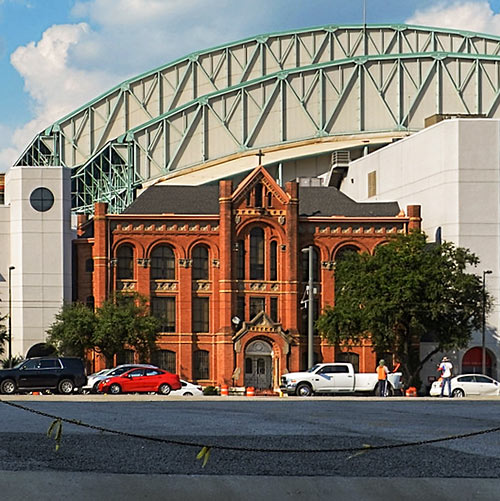 “There is a solution to this situation and it’s a little ironic.
The sisters of incarnate word want to stay downtown, but they say there’s no room.
John Nau and his group own the block right next door to the campus. They just announced that they were canceling their fund raising efforts and giving all of the money donated back to the donors for a Houston history museum.
It seems to me if John Nau wants to save some of Houston history, he could donate the block adjacent to the school so that that the historically important Nicholas Clayton building could be saved. That way his efforts to preserve history could still be accomplished, the nuns could stay downtown and the Nicholas Clayton building could be saved. Now that’s a lot easier than trying to figure out what to do with the dome!” [Bob R, commenting on Tearing Down Downtown’s Historic Incarnate Word Academy Building; A ‘Central Park’ for the Energy Corridor] Photo of Incarnate Word Academy, 600 Crawford St.: elnina
“There is a solution to this situation and it’s a little ironic.
The sisters of incarnate word want to stay downtown, but they say there’s no room.
John Nau and his group own the block right next door to the campus. They just announced that they were canceling their fund raising efforts and giving all of the money donated back to the donors for a Houston history museum.
It seems to me if John Nau wants to save some of Houston history, he could donate the block adjacent to the school so that that the historically important Nicholas Clayton building could be saved. That way his efforts to preserve history could still be accomplished, the nuns could stay downtown and the Nicholas Clayton building could be saved. Now that’s a lot easier than trying to figure out what to do with the dome!” [Bob R, commenting on Tearing Down Downtown’s Historic Incarnate Word Academy Building; A ‘Central Park’ for the Energy Corridor] Photo of Incarnate Word Academy, 600 Crawford St.: elnina
WHAT MICHAEL GRAVES BROUGHT TO HOUSTON  Is Michael Graves personally to blame for the infestations of flattened pediments that began appearing on commercial building façades in the early nineties, and later morphed into the default “look” for the standard midsprawl shopping center?
Not really. But the early acclaim his variety of postmodern design received did play some role in the license now apparently felt by thousands of lesser architects (and developers) to festoon dull commercial designs with all sorts of cartooned classical elements — and declare the result to be “traditional.” By the time the New Jersey-based architect designed his 2 Houston building projects in the early naughts, he had moved on to super-scaling other building elements: His Martel College and Master’s house at Rice and the Federal Reserve Bank (of Dallas!) on Allen Pkwy. (pictured above) are both dressed in a sort of Lego-like big-brick wallpaper, but one “drawn” using actual-size bricks. After an infection he contracted in 2003 left him paralyzed from the waist down, Graves became an outspoken champion of universal design. Graves passed away last week at the age of 80; Writer Michael Hardy has a remembrance of the man he calls “the architect Houston loved to hate.” [Houstonia] Photo: John D. Cramer
Is Michael Graves personally to blame for the infestations of flattened pediments that began appearing on commercial building façades in the early nineties, and later morphed into the default “look” for the standard midsprawl shopping center?
Not really. But the early acclaim his variety of postmodern design received did play some role in the license now apparently felt by thousands of lesser architects (and developers) to festoon dull commercial designs with all sorts of cartooned classical elements — and declare the result to be “traditional.” By the time the New Jersey-based architect designed his 2 Houston building projects in the early naughts, he had moved on to super-scaling other building elements: His Martel College and Master’s house at Rice and the Federal Reserve Bank (of Dallas!) on Allen Pkwy. (pictured above) are both dressed in a sort of Lego-like big-brick wallpaper, but one “drawn” using actual-size bricks. After an infection he contracted in 2003 left him paralyzed from the waist down, Graves became an outspoken champion of universal design. Graves passed away last week at the age of 80; Writer Michael Hardy has a remembrance of the man he calls “the architect Houston loved to hate.” [Houstonia] Photo: John D. Cramer

